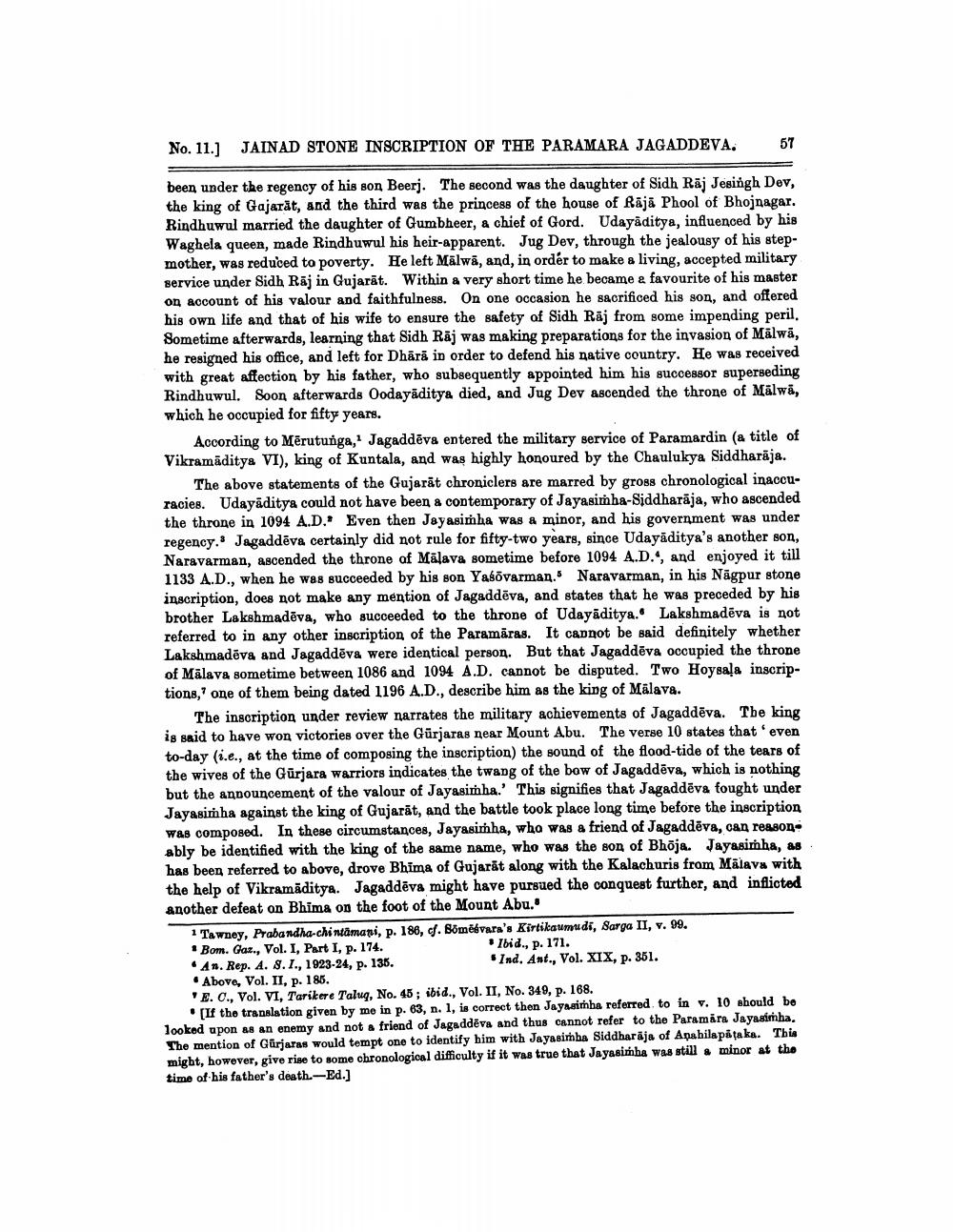________________
No. 11.) JAINAD STONE INSCRIPTION OF THE PARAMARA JAGADDEVA.
57
been under the regency of his son Beerj. The second was the daughter of Sidh Raj Jesingh Dev, the king of Gajarāt, and the third was the princess of the house of Rajā Phool of Bhojnagar. Rindhuwul married the daughter of Gumbheer, a chief of Gord. Udayaditya, influenced by his Waghela queen, made Rindhuwul his heir-apparent. Jug Dev, through the jealousy of his stepmother, was reduced to poverty. He left Mālwă, and, in order to make a living, accepted military service under Sidh Rāj in Gujarāt. Within a very short time he became a favourite of his master on account of his valour and faithfulness. On one occasion he sacrificed his son, and offered his own life and that of his wife to ensure the safety of Sidh Rāj from some impending peril. Sometime afterwards, learning that Sidh Raj was making preparations for the invasion of Mālwā, he resigned his office, and left for Dhäră in order to defend his native country. He was received with great affection by his father, who subsequently appointed him his successor superseding Rindhuwul. Soon afterwards Oodayāditya died, and Jug Dev ascended the throne of Mālwā, which he occupied for fifty years.
According to Mērutunga, Jagaddēva entered the military service of Paramardin (a title of Vikramāditya VI), king of Kuntala, and was highly honoured by the Chaulukya Siddharāja.
The above statements of the Gujarat chroniclers are marred by gross chronological inaccuracies. Udayāditya could not have been a contemporary of Jayasimha-Siddharāja, who ascended the throne in 1094 A.D.' Even then Jayasimha was a minor, and his government was under regency: Jagaddēva certainly did not rule for fifty-two years, since Udayāditya's another son, Naravarman, ascended the throne of Mālava sometime before 1094 A.D., and enjoyed it till 1133 A.D., when he was succeeded by his son Yaśõvarman. Naravarman, in his Nāgpur stone inscription, does not make any mention of Jagaddēva, and states that he was preceded by his brother Lakshmadēva, who succeeded to the throne of Udayāditya. Lakshmadēva is not referred to in any other inscription of the Paramāras. It cannot be said definitely whether Lakshmadēva and Jagaddēva were identical person. But that Jagaddēva occupied the throne of Mālava sometime between 1086 and 1094 A.D. cannot be disputed. Two Hoysala inscriptions, one of them being dated 1196 A.D., describe him as the king of Malava.
The inscription under review narrates the military achievements of Jagaddēva. The king is said to have won victories over the Gurjaras near Mount Abu. The verse 10 states that even to-day (i.e., at the time of composing the inscription) the sound of the flood-tide of the tears of the wives of the Gurjara warriors indicates the twang of the bow of Jagaddēva, which is nothing but the announcement of the valour of Jayasimha.' This signifies that Jagaddēva fought under Jayasimha against the king of Gujarāt, and the battle took place long time before the inscription Was composed. In these circumstances, Jayasimha, who was a friend of Jagaddēva, can reason ably be identified with the king of the same name, who was the son of Bhoja. Jayasimha, as has been referred to above, drove Bhima of Gujarat along with the Kalachuris from Mälava with the help of Vikramaditya. Jagaddēva might have pursued the conquest further, and inflicted another defeat on Bhima on the foot of the Mount Abu."
1 Tawnoy, Prabandha-chintamani, p. 186, cf. Sömēsvara's Kirtikaumudi, Sarga II, v. 99. * Bom. Gaz., Vol. I, Part I, p. 174.
Ibid., p. 171. • An. Rep. A. 8.1., 1923-24, p. 135.
Ind. Ant., Vol. XIX, p. 351. . Above, Vol. II, p. 185. 'E. O., Vol. VI, Tarikere Talug, No. 45; ibid., Vol. II, No. 349, p. 168.
.[If the translation given by me in p. 63, n. 1, is correct then Jayasinha referred to in v. 10 should be looked upon as an enemy and not a friend of Jagaddēva and thus cannot refer to the Paramira Jayasinha. The mention of Gürjaras would tempt one to identify him with Jayasimha Siddharaja of Anahila pataka. This might, however, give rise to some chronological difficulty if it was true that Jayasimha was still minor at the time of his father's death. -Ed.]




